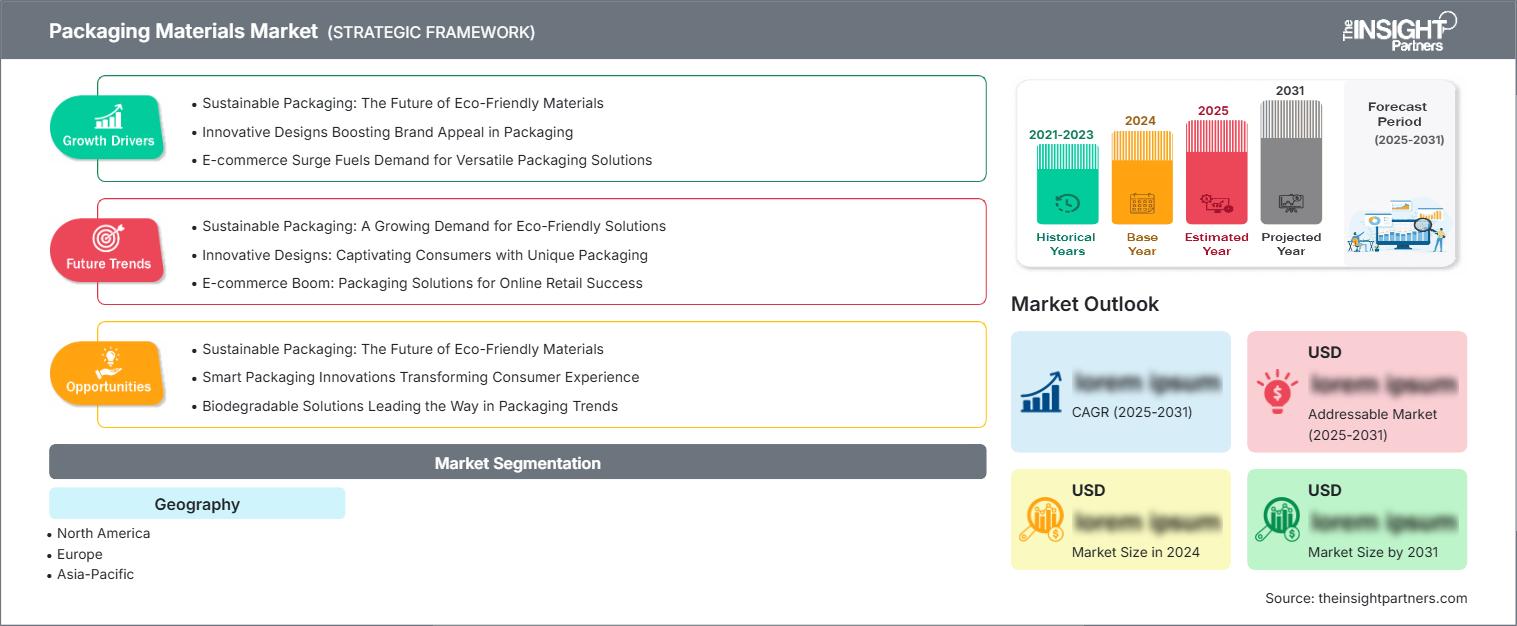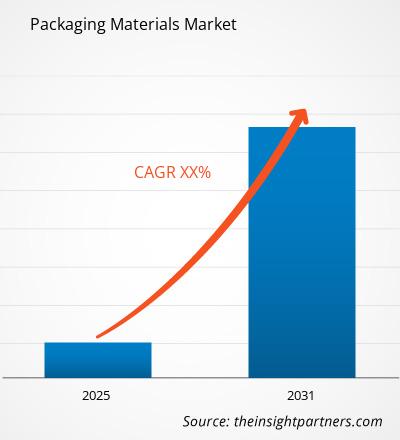تحليل السوق
مواد التغليف هي المواد المستخدمة لتوفير طبقة واقية للمنتجات. تنقسم هذه الطبقات إلى أولية، وثانوية، وثالثية؛ والطبقة الأولى هي الأكثر أهمية، إذ توفر غطاءً واقيًا للمنتج يمنعه من الانسكاب والتلوث بالبيئة الخارجية. أما الطبقة الثانوية فتوفر غطاءً واقيًا أكثر فعالية، مما يعزز سهولة التعامل. أما التغليف الثالثي، أو التغليف من المستوى الثالث، فيستخدم مواد التغليف لنقل البضائع بكميات كبيرة من مكان إلى آخر.
محركات النمو والتحديات
أدى نمو وتوسع مختلف قطاعات المستهلك النهائي، مثل الرعاية الصحية، والأغذية والمشروبات، ومستحضرات التجميل، وطرح منتجات جديدة في السوق، إلى تعزيز الطلب على مواد التغليف. كما أن ازدياد التسوق عبر التجارة الإلكترونية نتيجةً لتغير أنماط الحياة يُسهم في نمو سوق مواد التغليف. كما يُعدّ ارتفاع الدخل المتاح للإنفاق، وتزايد الطلب على مجموعة متنوعة من المنتجات الاستهلاكية، العامل الأهم في تحديد نمو سوق مواد التغليف. وقد شهدت صناعة التجارة الإلكترونية حول العالم نموًا هائلًا في السنوات القليلة الماضية. ووفقًا للمفوضية الأوروبية، فإن 74% من مستخدمي الإنترنت في الاتحاد الأوروبي تسوقوا عبر الإنترنت في عام 2021.
ستحصل على تخصيص لأي تقرير - مجانًا - بما في ذلك أجزاء من هذا التقرير، أو تحليل على مستوى الدولة، وحزمة بيانات Excel، بالإضافة إلى الاستفادة من العروض والخصومات الرائعة للشركات الناشئة والجامعات
سوق مواد التعبئة والتغليف: رؤى استراتيجية

- احصل على أهم اتجاهات السوق الرئيسية من هذا التقرير.ستتضمن هذه العينة المجانية تحليل البيانات، بدءًا من اتجاهات السوق وحتى التقديرات والتوقعات.
بالإضافة إلى ذلك، ووفقًا لتقرير PostNord AB بعنوان "التجارة الإلكترونية في أوروبا"، فقد ارتفع عدد مستهلكي التجارة الإلكترونية في أوروبا من 286 مليونًا في عام 2021 إلى 297 مليونًا في عام 2021. وتضمن العديد من شركات التجارة الإلكترونية مثل Tesco و Amazon للعملاء إمكانية تسوق السلع المطلوبة بسهولة عبر الإنترنت باستخدام تطبيقات التجارة الإلكترونية للهواتف الذكية. وفي سلسلة قيمة التجارة الإلكترونية، تُعد التعبئة والتغليف الجذابة استراتيجية حاسمة لأصحاب العلامات التجارية لتمييز منتجاتهم. ويتحول أصحاب العلامات التجارية من الصناديق المموجة التقليدية إلى خيارات التعبئة والتغليف المتنوعة للتميز. كما تزيد شعبية التسوق عبر الإنترنت من استخدام التعبئة والتغليف الشخصية. وبالتالي، فإن التفضيل الكبير للتسوق عبر الإنترنت والتجارة الإلكترونية يدفع الطلب على مواد التعبئة والتغليف. ومع ذلك، فإن أنواع البلاستيك المختلفة المستخدمة في مواد التعبئة والتغليف ليست خيارًا جيدًا. سيؤدي الحظر واللوائح المختلفة المفروضة على مواد التعبئة والتغليف البلاستيكية بسبب المخاوف البيئية إلى تدهور معدل نمو السوق. بالإضافة إلى ذلك، فإن التقلبات في أسعار المواد الخام ستعيق أيضًا نمو السوق.
رؤى إقليمية حول سوق مواد التعبئة والتغليف
قام محللو شركة "ذا إنسايت بارتنرز" بشرح شامل للاتجاهات الإقليمية والعوامل المؤثرة في سوق مواد التغليف خلال فترة التوقعات. ويناقش هذا القسم أيضًا قطاعات سوق مواد التغليف ونطاقه الجغرافي في أمريكا الشمالية، وأوروبا، وآسيا والمحيط الهادئ، والشرق الأوسط وأفريقيا، وأمريكا الجنوبية والوسطى.
نطاق تقرير سوق مواد التعبئة والتغليف
| سمة التقرير | تفاصيل |
|---|---|
| حجم السوق في عام 2024 | XX مليون دولار أمريكي |
| حجم السوق بحلول عام 2031 | XX مليون دولار أمريكي |
| معدل النمو السنوي المركب العالمي (2025 - 2031) | XX% |
| البيانات التاريخية | 2021-2023 |
| فترة التنبؤ | 2025-2031 |
| المناطق والبلدان المغطاة | أمريكا الشمالية
|
| قادة السوق وملفات تعريف الشركات الرئيسية |
|
كثافة اللاعبين في سوق مواد التعبئة والتغليف: فهم تأثيرها على ديناميكيات الأعمال
يشهد سوق مواد التغليف نموًا سريعًا، مدفوعًا بتزايد طلب المستخدم النهائي نتيجةً لعوامل مثل تطور تفضيلات المستهلكين، والتقدم التكنولوجي، وزيادة الوعي بمزايا المنتج. ومع تزايد الطلب، تعمل الشركات على توسيع عروضها، والابتكار لتلبية احتياجات المستهلكين، والاستفادة من الاتجاهات الناشئة، مما يعزز نمو السوق.

- احصل على نظرة عامة على أهم اللاعبين الرئيسيين في سوق مواد التعبئة والتغليف
تقسيم التقرير ونطاقه
يُعد "تحليل سوق مواد التغليف العالمية حتى عام 2031" دراسة متخصصة ومتعمقة تُركز على اتجاهات السوق العالمية وفرص النمو. يهدف التقرير إلى تقديم لمحة عامة عن سوق مواد التغليف العالمية، مع تقسيم السوق تفصيليًا حسب المادة ونوع المنتج والتطبيق والموقع الجغرافي. وقد شهد سوق مواد التغليف العالمي نموًا كبيرًا في الآونة الأخيرة، ومن المتوقع أن يستمر هذا النمو خلال فترة التوقعات. يقدم التقرير إحصاءات رئيسية حول استهلاك مواد التغليف عالميًا والطلب عليها في المناطق والدول الرئيسية. بالإضافة إلى ذلك، يُقدم التقرير تقييمًا نوعيًا لمختلف العوامل المؤثرة على أداء سوق مواد التغليف في المناطق والدول الرئيسية. كما يتضمن التقرير تحليلًا شاملًا للشركات الرائدة في سوق مواد التغليف وأهم تطوراتها الاستراتيجية. كما يتضمن التقرير العديد من التحليلات حول ديناميكيات السوق للمساعدة في تحديد العوامل الرئيسية الدافعة، واتجاهات السوق، وفرص سوق مواد التغليف المربحة، والتي بدورها تُساعد في تحديد مصادر الدخل المهمة.
علاوةً على ذلك، يوفر تحليل النظام البيئي وتحليل بورتر للقوى الخمس رؤيةً شاملةً لسوق مواد التعبئة والتغليف العالمية. وهذا يُساعد على فهم سلسلة التوريد بأكملها وعوامل نمو السوق المختلفة.
التحليل القطاعي
يُقسّم سوق مواد التغليف العالمي حسب المادة ونوع المنتج والاستخدام. ويُقسّم سوق مواد التغليف، حسب المادة، إلى الورق والكرتون، والبوليمر، والمعادن، والزجاج والخشب، والمنسوجات، وغيرها. أما حسب نوع المنتج، فيُصنّف السوق إلى حاويات ومرطبانات، وأكياس، وأكياس وأغلفة، وسدادات وأغطية، وصناديق، وبراميل، وغيرها. ويُصنّف سوق مواد التغليف حسب الاستخدام إلى: الأغذية والمشروبات، والرعاية الصحية، والعناية الشخصية، ومستحضرات التجميل، والمواد الكيميائية، وغيرها.
بناءً على تطبيقاتها، شكّل قطاع الأغذية والمشروبات حصةً كبيرةً في سوق مواد التغليف، ويُعزى ذلك إلى شعبيته العالمية وتوافره الواسع. ويُسهم الطلب المتزايد على الأغذية المعبأة في جميع المناطق في نمو صناعة الأغذية والمشروبات. كما يُسهم الطلب المتزايد على منتجات العناية الشخصية ومستحضرات التجميل بشكل غير مباشر في نموّ سوق مواد التغليف.
التحليل الإقليمي
يقدم التقرير نظرة عامة مفصلة على سوق مواد التغليف العالمية في خمس مناطق رئيسية: أمريكا الشمالية، وأوروبا، وآسيا والمحيط الهادئ، والشرق الأوسط وأفريقيا، وأمريكا الجنوبية والوسطى. ومن المتوقع أن تستحوذ أمريكا الشمالية على حصة كبيرة من سوق مواد التغليف عالميًا. وقد ساهم تزايد الإقبال على المنتجات الغذائية المعبأة، وازدهار قطاع التجارة الإلكترونية، وزيادة الطلب على منتجات العناية الشخصية ومستحضرات التجميل، وغيرها، بشكل إيجابي في نمو السوق في أمريكا الشمالية. ومن المتوقع أيضًا أن تشهد أوروبا نموًا ملحوظًا خلال فترة التوقعات. كما يُتوقع أن تكون منطقة آسيا والمحيط الهادئ سوقًا جاذبة لمواد التغليف خلال فترة التوقعات، نظرًا لنمو صناعات الاستخدام النهائي، مثل الأغذية والمشروبات، والرعاية الصحية، والعناية الشخصية، ومستحضرات التجميل، وغيرها.
تطورات الصناعة والفرص المستقبلية
وكانت الشراكات والاستحواذات وإطلاق منتجات جديدة هي الاستراتيجيات الرئيسية التي تبناها اللاعبون العاملون في سوق مواد التعبئة والتغليف العالمية.
في يونيو 2021، أعلنت أمازون الهند أنها ستستبدل جميع المواد البلاستيكية التي تستخدم لمرة واحدة في التعبئة والتغليف من أكثر من 50 موقعًا للوفاء بمنتجاتها في جميع أنحاء البلاد بورق خالٍ من البلاستيك وقابل للتحلل البيولوجي.
في أبريل 2021، استحوذت شركة Greif Inc. على حصة أقلية في شركة Centurion Container LLC لتوسيع شبكتها لتجديد حاويات الشحن المتوسطة (IBC) في أمريكا الشمالية. تُعزز هذه الاتفاقية قدرتها على تقديم حلول تغليف صديقة للبيئة.
تأثير كوفيد/ تأثير السيناريو الجيوسياسي/ تأثير الركود
أدى جائحة كوفيد-19 إلى تراجع في تقدم العديد من الصناعات في جميع أنحاء العالم. أدى إغلاق مصانع التصنيع وتقييد التجارة في جميع أنحاء العالم إلى قيود على سلسلة التوريد للمصنعين في جميع أنحاء العالم. شهد سوق مواد التعبئة والتغليف ركودًا خلال الوباء بسبب التجارة المحدودة للمواد الخام عالميًا. يتم استيراد العديد من المواد الخام المستخدمة في التعبئة والتغليف من دول في جميع أنحاء العالم، مما يؤدي إلى محدودية توافر المنتجات. علاوة على ذلك، تراجعت العديد من الصناعات النهائية، مثل الأغذية والمشروبات والرعاية الصحية والعناية الشخصية ومستحضرات التجميل والمواد الكيميائية، وما إلى ذلك، خلال هذه الفترة بسبب نقص المواد الخام ومحدودية المعروض من العمالة. وقد أثر ذلك سلبًا على سوق مواد التعبئة والتغليف. ومع ذلك، يتعافى السوق العالمي من الخسائر حيث أعلنت حكومات مختلف الدول عن تخفيف القيود. يمكن للمصنعين العمل بكامل طاقتهم، مما يساعدهم على التغلب على فجوة العرض.
علاوة على ذلك، يُعزز ارتفاع معدل التطعيم النمو الإجمالي للقطاع بشكل إيجابي. وقد أدت الجائحة إلى تغيير في عادات الشراء لدى المستهلكين. فخلال جائحة كوفيد-19، تحوّل المستهلكون حول العالم نحو شراء الأغذية والمشروبات والمنتجات الصيدلانية عبر الإنترنت. وهذا العامل سيفتح آفاق نمو مربحة لسوق مواد التعبئة والتغليف خلال الفترة المتوقعة.
المشهد التنافسي والشركات الرئيسية
تشمل بعض اللاعبين الرئيسيين العاملين في سوق مواد التعبئة والتغليف Amcor plc و Honeywell International Inc. و Alcoa Corporation و Bemis Manufacturing Company و Graham Packaging Company و CKS Packaging, Inc. و ProAmpac. و Mondi و Berry Global Inc. و AVERY DENNISON CORPORATION. و Bayer AG و Tetra Pak Group و InMat Inc. و Avient Corporation و A-ROO COMPANY LLC. و FlexPak Services و Amerplast و Ajover SAS و Oliver Packaging & Equipment Company و Sealed Air و 3M وغيرها.
- التحليل التاريخي (سنتان)، سنة الأساس، التوقعات (7 سنوات) مع معدل النمو السنوي المركب
- تحليل PEST و SWOT
- حجم السوق والقيمة / الحجم - عالمي، إقليمي، بلد
- الصناعة والمنافسة
- مجموعة بيانات إكسل
التقارير الحديثة
شهادات العملاء
سبب الشراء
- اتخاذ قرارات مدروسة
- فهم ديناميكيات السوق
- تحليل المنافسة
- رؤى العملاء
- توقعات السوق
- تخفيف المخاطر
- التخطيط الاستراتيجي
- مبررات الاستثمار
- تحديد الأسواق الناشئة
- تحسين استراتيجيات التسويق
- تعزيز الكفاءة التشغيلية
- مواكبة التوجهات التنظيمية






















 احصل على عينة مجانية ل - سوق مواد التعبئة والتغليف
احصل على عينة مجانية ل - سوق مواد التعبئة والتغليف